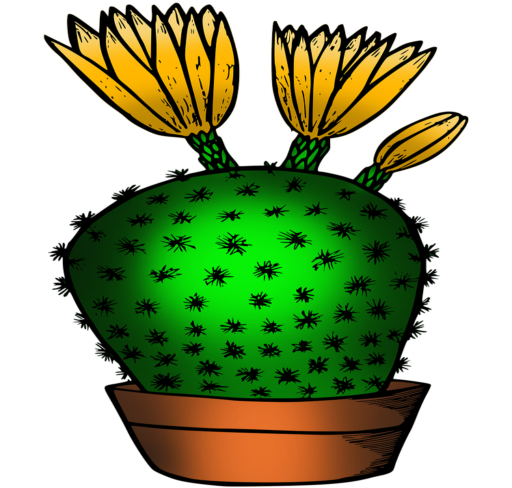What’s Happing in the Albuquerque, New Mexico High Desert Gardens in July?
High Desert Gardens in July are growing robustly. Daytime temperatures range from mid-eighties to the high nineties. Occasionally it will hit 100 degrees or a little more, but not too often.
What is Growing in High Desert Gardens in July?
Corn, Green Beans and Tomatoes are a few of the Vegetables Growing Well in the July Summer Garden.
Kandy Corn
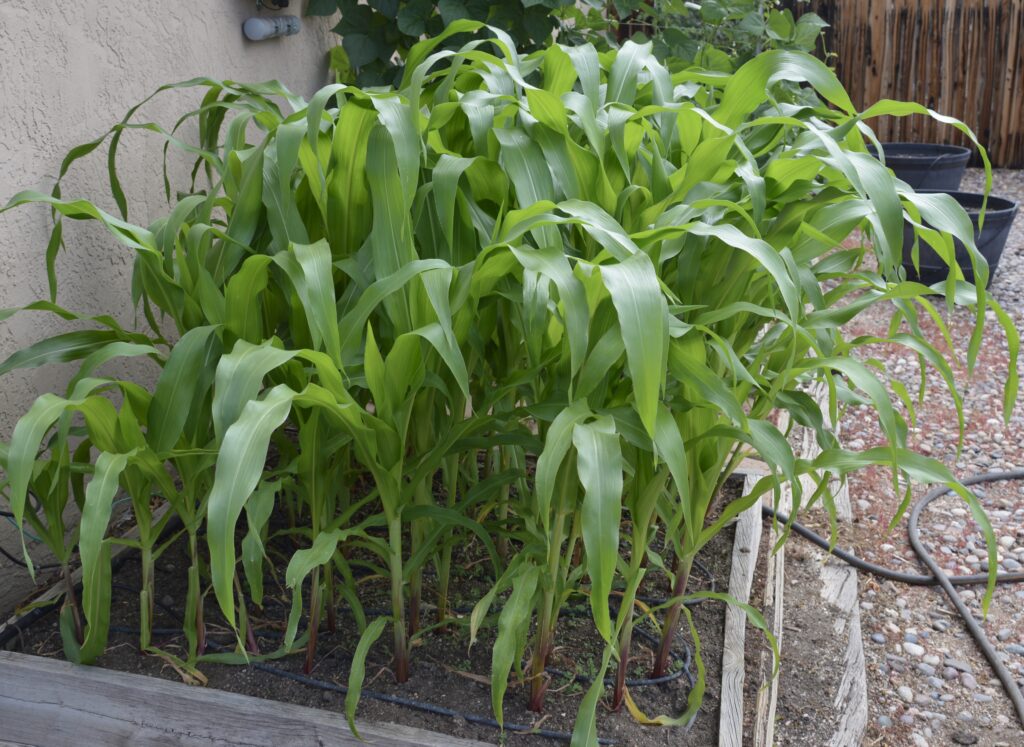
A very sweet corn. 80-90 days. Non-GMO. Kandy Korn Hybrid variety of corn seeds grow to be seven feet tall stalks, which provide large, eight-inch ears of yellow corn with a sweet flavor. See More…Corn
In one 4×4 foot garden, planted Kandy Corn seed about 10” apart on June 1st.
Currently 3-4 feet tall and growing robustly. No baby corn yet.
Big N Tender Corn
In another 4×4 foot garden I planted Big N Tender corn with 12” spacing. 79 days. Aptly named, this bicolor corn produces beautifully uniform, 8-inch ears with 16 very straight rows of tender, juicy kernels. The 7-8-foot-tall plants are high yielding and dependable, with well-filled, hefty, very attractive ears.
Keep the corn well-watered. Watering the corn deeply 3 times a week. Corn has deep roots, so it’s better to water deeply and less frequently. Keep the garden weeded as corn doesn’t like competition for nutrients. Feed with organic compost and an organic fish fertilizer such as “Alaska”. It’s a liquid fish fertilizer with ratios of 5.1.1. It’s a mild fertilizer with 5 parts nitrogen, 1 part phosphorus, and 1 part potassium. Two tablespoons of the liquid fertilizer per gallon of water works well. Corn is a very heavy feeder. Feeding all my established plants about every 3 weeks keeps them healthy and growing strong. Two of my four-foot square gardens are planted with corn.
Saving Space in the Garden
For saving space corn and winter squash can be successfully planted together. Because corn grows vertically and winter squash have a sprawling habit, the two can be grown in the same plot to save space. Some growers believe that the scratchy leaves of the squash plants also help discourages raccoons from eating the corn. At the very least, the spreading squash plants reduce the need for weeding around the corn. Make sure the soil is fertile and the plants are irrigated well because both crops are very heavy feeders.
Corn and Pole Beans
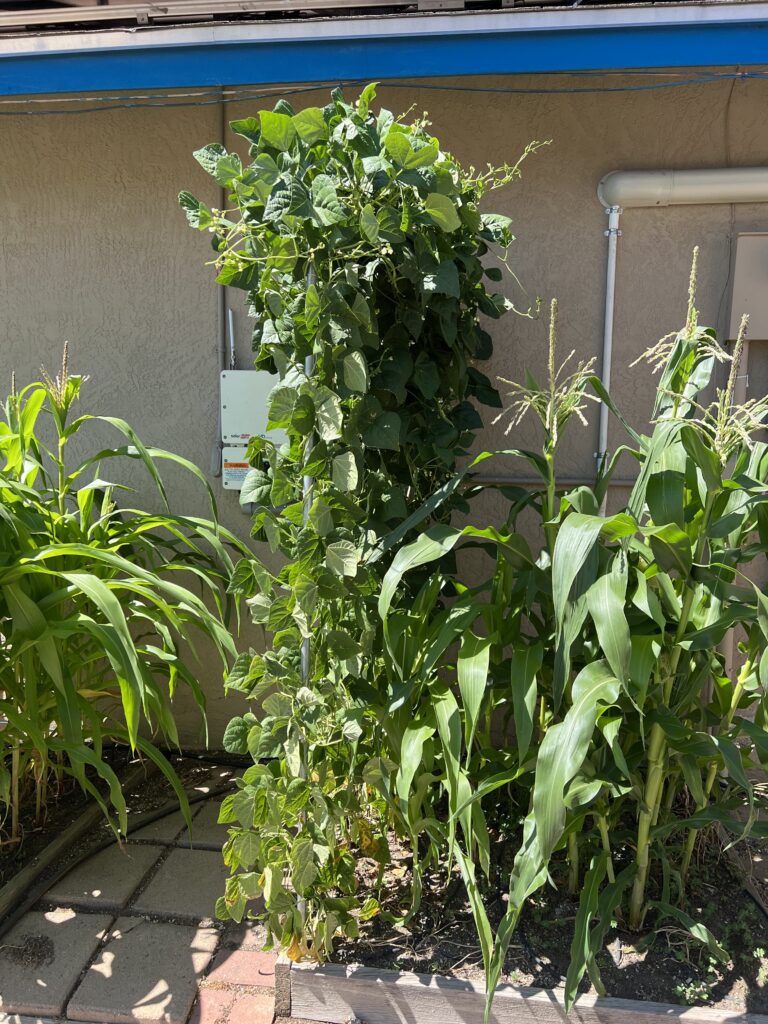
Corn stalks can provide a structure for pole beans to climb. Sow two or three pole beans around each corn stalk a few weeks after the corn has emerged from the soil and begun to grow. The beans make an especially great companion for corn, since they fix nitrogen into the soil, helping the corn (a very heavy-feeding crop) get the nutrients that it needs. See More…Green Beans
Control of Corn Earworm – Tips to Prevent Corn Earworm
Sweet corn season is here, and there’s nothing like eating freshly harvested ears – unless you find a worm when peeling back the husks! That unwanted intruder is usually the corn earworm.
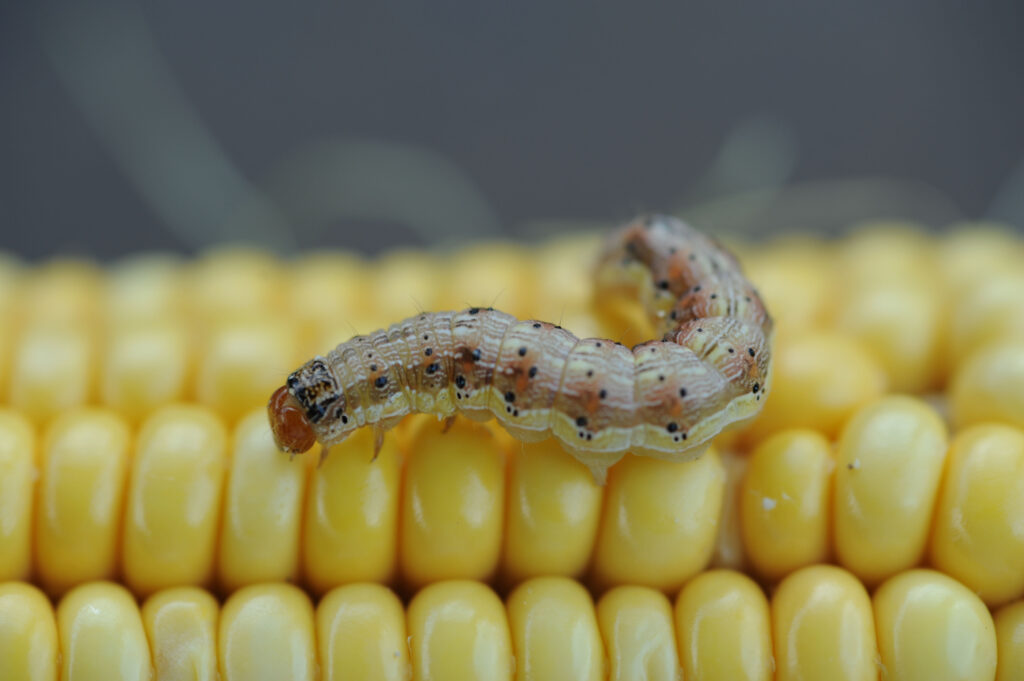
Identification
These caterpillars vary widely in color and may be green, brown, pink, black or various shades between these colors, with light and dark stripes along its sides and back. The head is always a yellow or light brown color, without any spots. Eventually they grow to about to 1.5 to 2 inches long.
The adult corn earworm is a grayish-brown, night-flying moth with a wingspan of about 1.5 inches. Female moths prefer to lay their eggs on fresh corn silks but will also choose buds and growing tips of young corn if silks aren’t available. The tiny, light-yellow eggs are laid singly. By the time the eggs hatch in a few days, they have turned to a dark brown.
The little caterpillars crawl down the silks to the tip of the ear to feed on the maturing corn kernels. Since they are cannibalistic – meaning they will eat each other and the strongest or largest caterpillar wins – you typically will only find one in each ear of corn.
Corn earworm, also known as the tomato fruit worm and cotton bollworm, has a wide range of plants it feeds on besides corn. Other vegetables it will consume include tomatoes, peppers, beans, cabbage, and soybeans. They prefer corn, but late in the season when corn kernels are maturing and not as attractive, they will damage tomatoes and snap beans by eating into the fruits or pods.
Home Garden Control of Corn Earworms
There are several options for controlling corn earworm in the home garden, but if you’d rather not use insecticides, you can always just cut off the damaged parts of infested ears, as the portion not fed on by the caterpillar is still perfectly good.
Plant early. Sweet corn harvested before mid-August will have fewer, or no, earworms. Check the number of days from seed to harvest on the seed package and look for those that can be harvested in less than 70 days. Plant as early as soil temperatures are right for seed germination, typically 55°F for standard sweet corn and 65°F for Supersweet cultivars.
Experiment with cultivars. Try using a variety of sweet corn cultivars and planting dates to find which combination gives the most control. Corn varieties with tight husks at the ear tips are naturally more resistant to earworms.
Natural enemies. There are several natural enemies that attack corn earworm eggs. Several tiny wasps parasitize the eggs, while minute pirate bugs eat the eggs. There are also wasps that attack corn earworm larvae and pupae; however, these beneficial insects are not numerous enough to provide acceptable control.
Use oil. If you only have a few corn plants, try using vegetable or corn oil for control. Apply 5 drops of the mixture with an eyedropper to the tip of each ear. As the young worms travel from their hatching spot on the silk into the ear, they will suffocate as they move through the oil.
As strange as it may sound, to prevent corn earworms from attaining entry to the ears, try placing clothespins where the silk joins the ear. This will block the worm’s access and can be quite successful on a small scale.
Harvesting Sweet Corn
Harvest when ears feel well filled when squeezed, and when kernels are plump and “milky” (you can peel back the wrapper leaves and puncture a kernel with your thumbnail to check) This usually happens 18 to 24 days after ear silks appear.
Tomatoes
Tomato plants are now growing rapidly. Four of my four-foot square raised gardens are each planted with 4 tomato plants. The tomatoes are growing fast and putting on new fruit daily. See More…Tomatoes
Sweet Million Hybrid Tomato
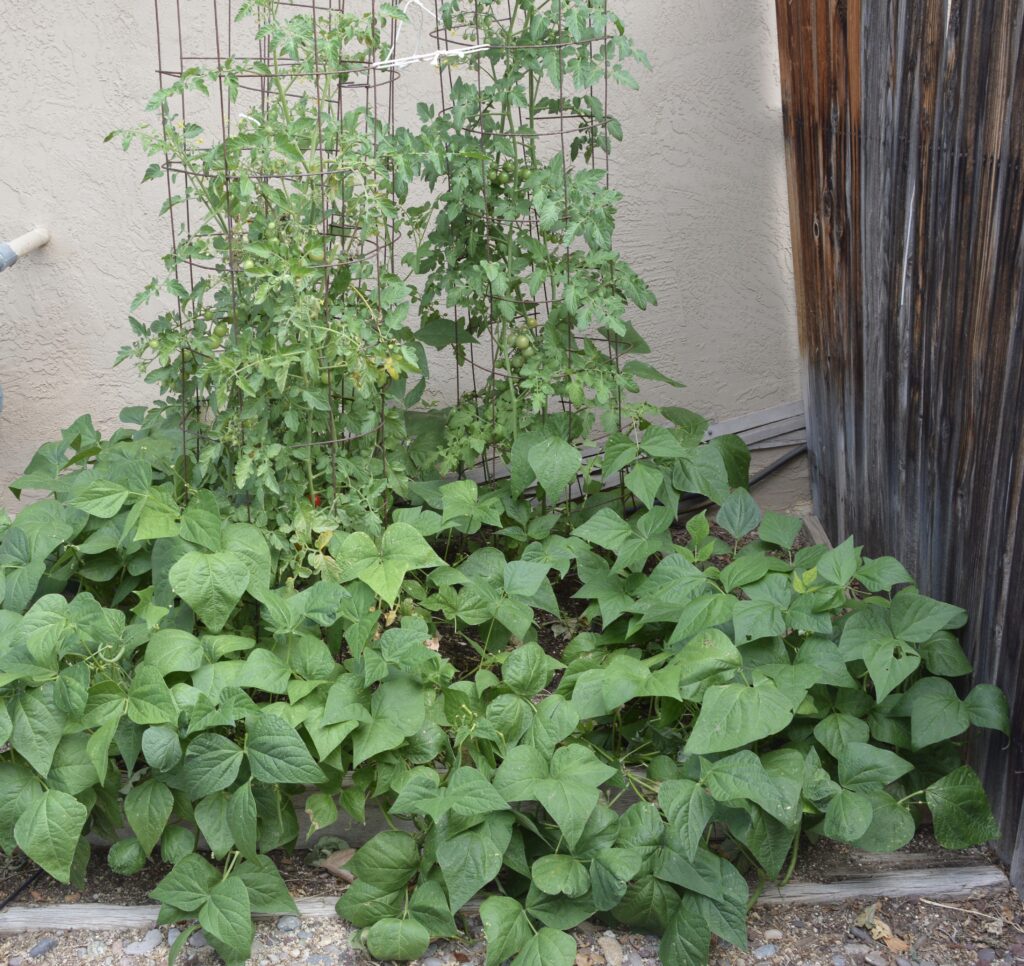
4 plants each of Sweet Million Hybrid cherry tomatoes. The sugary sweet, round, ½ in. fruits set in grapelike clusters—and the vines churn out tomatoes all season long. The superbly flavored tomatoes are excellent for fresh eating, salads, pickling and preserves.
Umamin Hybrid Tomato
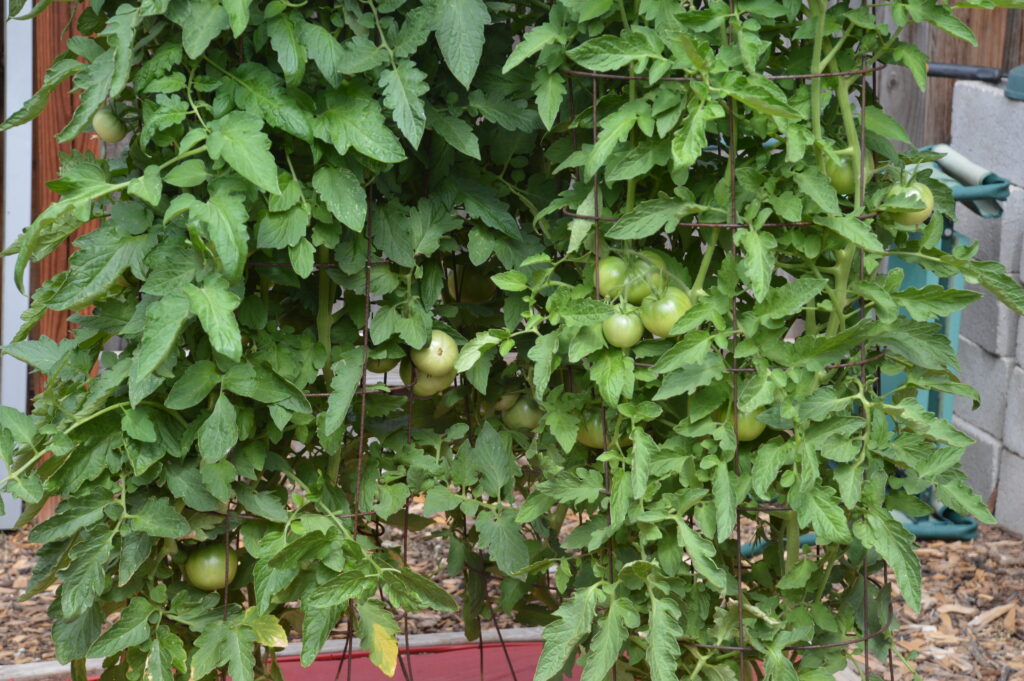
4 plants each of Umamin a large slicing tomato.
This 6-8 oz. tomato has a delectably bold, savory flavor. ‘Umamin’ describes a distinctive flavor experience: one unique from the four main primary tastes: sweet, sour, bitter, and salty. It is highly disease resistant. The plants are currently loaded with green ripening tomatoes.
Medium Rare Hybrid Tomato
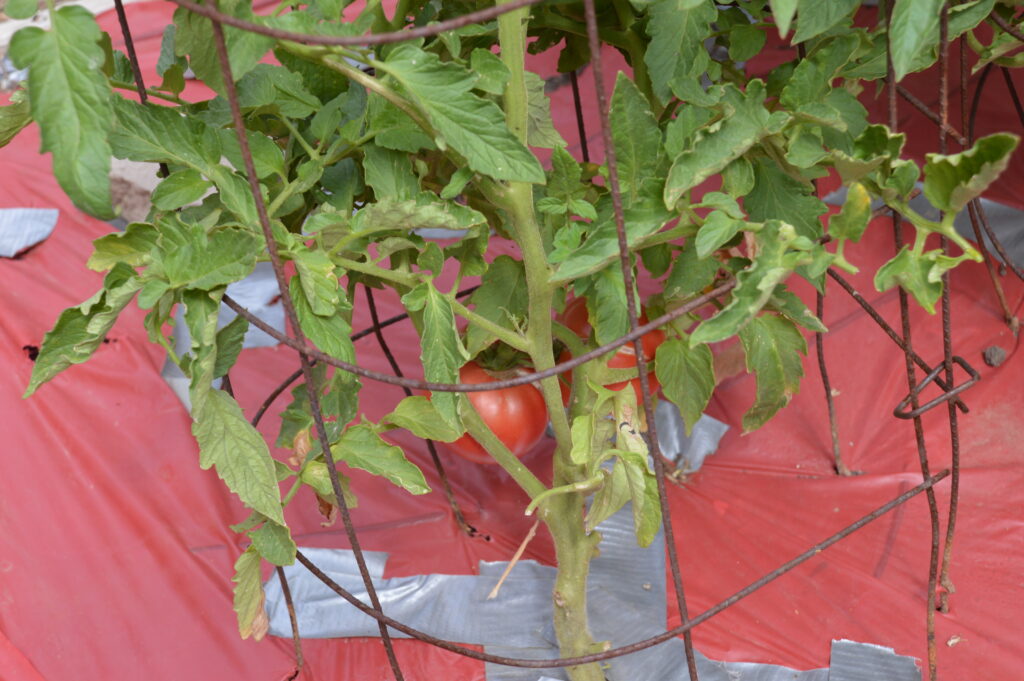
4 plants each of Medium Rare a large pink beefsteak tomato loaded with savory and smoky flavor.
These Medium Rare tomatoes have an earthy fragrance and rich, meaty flavor. Medium Rare’s translucent pink color lets more light into the huge 16–18 oz. fruits. Many of the tomatoes are ripe and ready for eating.
SuperSauce Hybrid Tomato
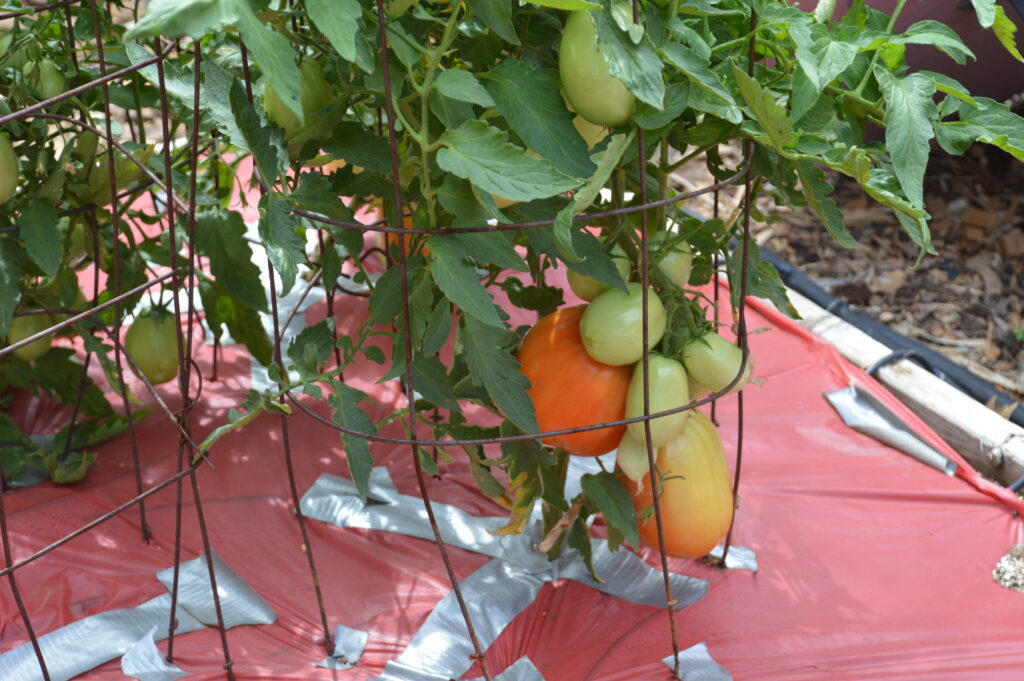
4 plants each of Super Sauce a very large Roma type tomato.
This SuperSauce tomato is called the worlds largest sauce tomato. This huge Roma weighs about 2 pounds each and are the largest Roma tomatoes I’ve ever seen. Several of these tomatoes have ripened and make fantastic sauce.
Now harvesting a few ripe tomatoes from each plant weekly. The tomato baskets are 7’ tall and some of the tomatoes have already reached that height. I love tomatoes and look forward to growing more than we can eat. After that I get to share with family and friends.
Jade Bush Green Beans
Planted Jade bush green beans around the outside of the tomato baskets. This variety has round and straight bean pods that grow long. They are an excellent jade green color and are packed with flavor. They are also fantastic for storing because they keep for long periods after they are harvested. Plants grow in a bush growth habit giving the pods plenty of room off the ground.
They have been producing beautiful 8 to 10 inch straight smooth dark green beans. When picked at this size, they are tender, stringless, and delicious. The “bush” beans grow fast and early so give a tasty crop early in the summer. See More…Green Beans
Blue Lake Pole Green Beans
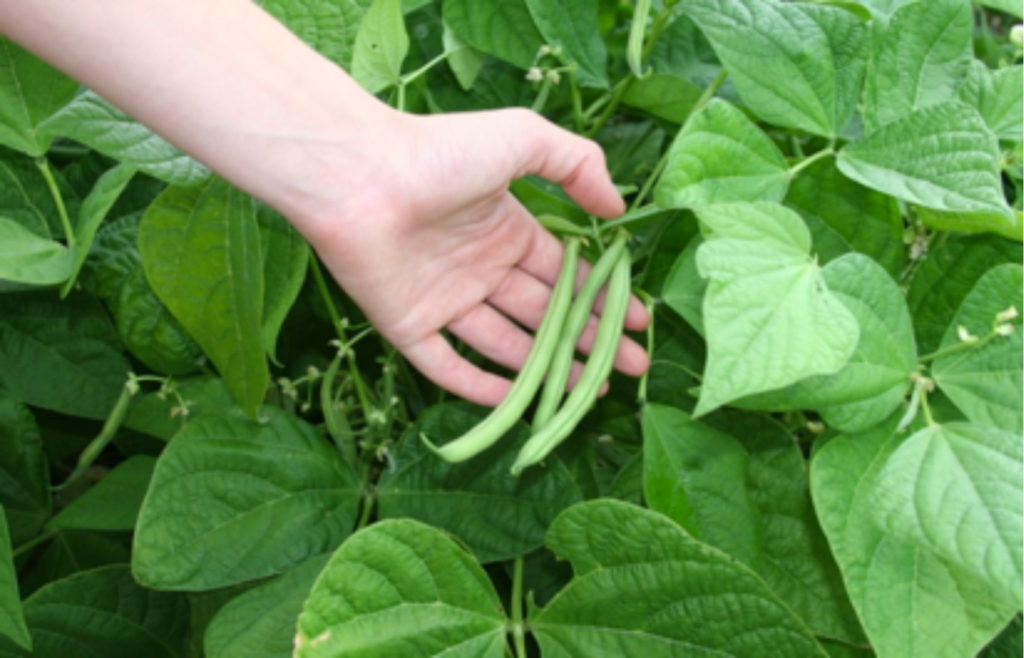
The Blue Lake Pole Green Beans which were planted at the same time as the Jade bush beans, back in early March, are growing strong and filling up a 7-foot trellis. A lot of beans in a smaller space. Blue Lake Pole Bean sets pods from the base to the top of the vine—so plenty for eating fresh and processing. Produces heavy yields of straight, smooth 6 in. pods that are crisp and stringless at all phases.
They now have flowers and are starting to grow green bean pods. If these are kept harvested (Picked Daily) they will produce until the first frost in the fall.
The mix of bush and pole beans works out well. Just as the bush beans are finished with their harvest the pole beans are just beginning theirs. This means having a nice supply of green beans all summer long.
Yukon Gold Potatoes
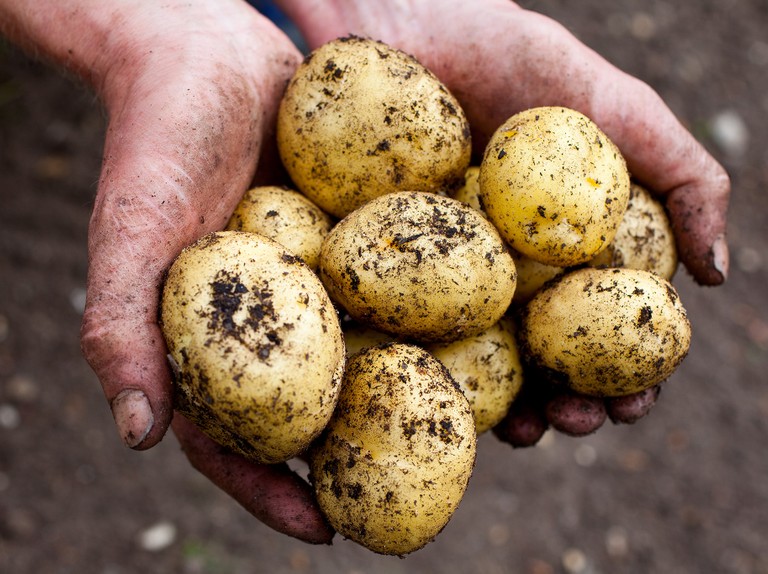
Just harvested twenty pounds of Yukon Gold potatoes from two 50 gallon, cut in ½ whiskey barrels. These barrels were planted in early spring. Have replanted for a second harvest. Planted in a mix of compost and soil, plus 5 cups of bone meal to each barrel. I have been able to get 2 harvests in summers past. Each year I empty the barrels of the compost and put it on other gardens that will not be growing potatoes or tomatoes. In the following spring these barrels will get all new compost and bone meal and start again growing potatoes. See More…Potatoes
Herb Garden
The four-foot square raised Herb Garden is in full production mode this very warm summer. See More…Raised Beds
What’s in that herb garden?
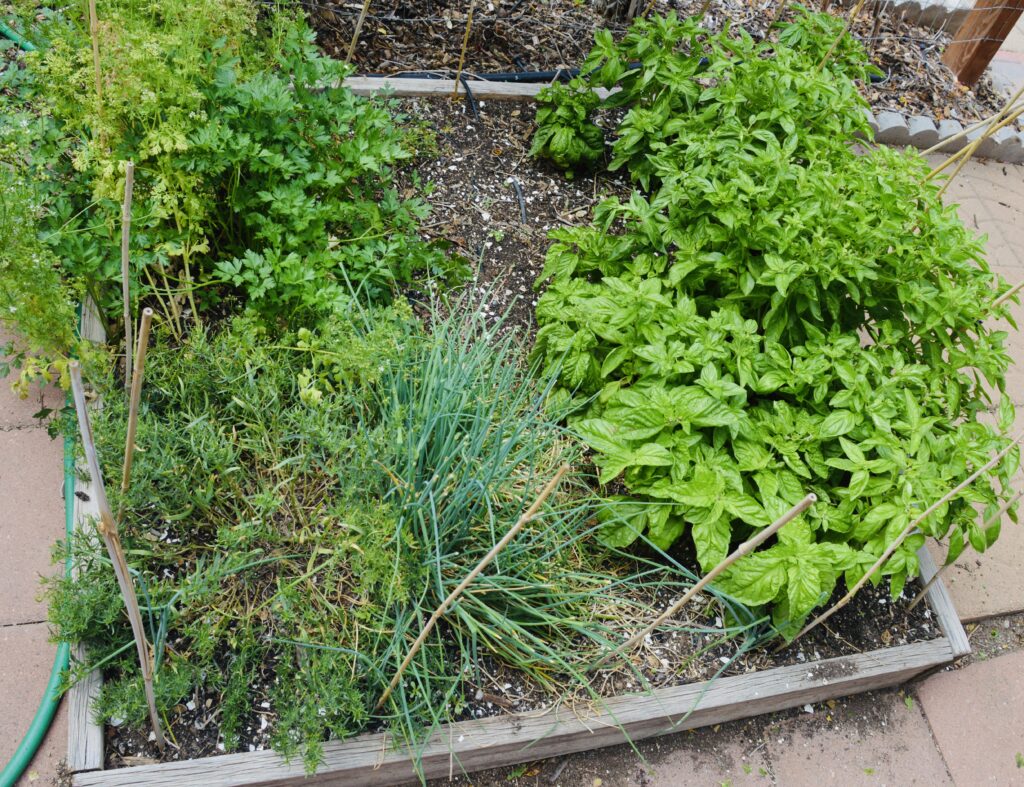
Mammoth Basil
Mammoth basil is a lettuce leaf basil and has leaves that can stretch out. Featuring large, dark green, luscious, leaves, a chefs dream herb. Growing very well, however, it is often limp in the hot High Desert sun.
Genovese Basil
Always a winner in the hot desert sun. The basil is looking great, growing very fast. It’s important to keep the flowering buds trimmed daily, so the basil produces more leaves. Genovese basil is consistently year after year a great producer.
Italian Plain Dark Green Parsley
This parsley also seems to enjoy the hot desert sun. Growing very well with beautiful full of leaves plants.
Cruiser Cilantro
This cilantro grows so fast in the summer heat, it has already gone to seed. I am hoping to plant these seeds for a fall planting. We shall see what happens.
Chives
These perennial plants are doing very well. I’ve had these growing every year for so long I don’t know which chive plants these are. They produce a big, tasty bunch of chives every year.
Tarragon
French Tarragon Herb
Bought this wonderful perennial plant in 2019. It has produce a big cluster of tarragon every year since.
Watering
The Summer Monsoon produced some ½ inch rains. You need to know how much rainwater is getting to your gardens. A general rule of thumb; if you don’t get at least ½″ of rain, most soils will only be wet 3 to 4″ deep, leaving the roots dry beneath. If you get several ½″ rains in a row the soil moisture will be pushed deeper. Otherwise, you’ll need to irrigate. It’s strongly suggested to get a rain gauge so you will know how much rain you are getting to the gardens. See More: Water Conservation is Critical for Desert Vegetable Gardens
For fresh transplants regular watering during the first growing season is essential to growing a sturdy, deep root system. Through watering deeply and regularly at the start of the summer heat, you’ll save water in the long run as the plants will establish more quickly.
New transplants require mulching. Place mulch materials (coarse compost, pine needles, or finely shredded bark) to a depth of one inch directly under the plants as well as cover any bare soil around them. Mulching decreases transplanting trauma by keeping the soil more evenly cool and moist.
Be sure the plants have a wide, one-inch-deep saucer like bowl around their base to hold water. Fill the depression with mulch to keep the soil cool and damp. Water twice and fill the bowl to near overflowing, let it penetrate the soil and fill the saucer again.
